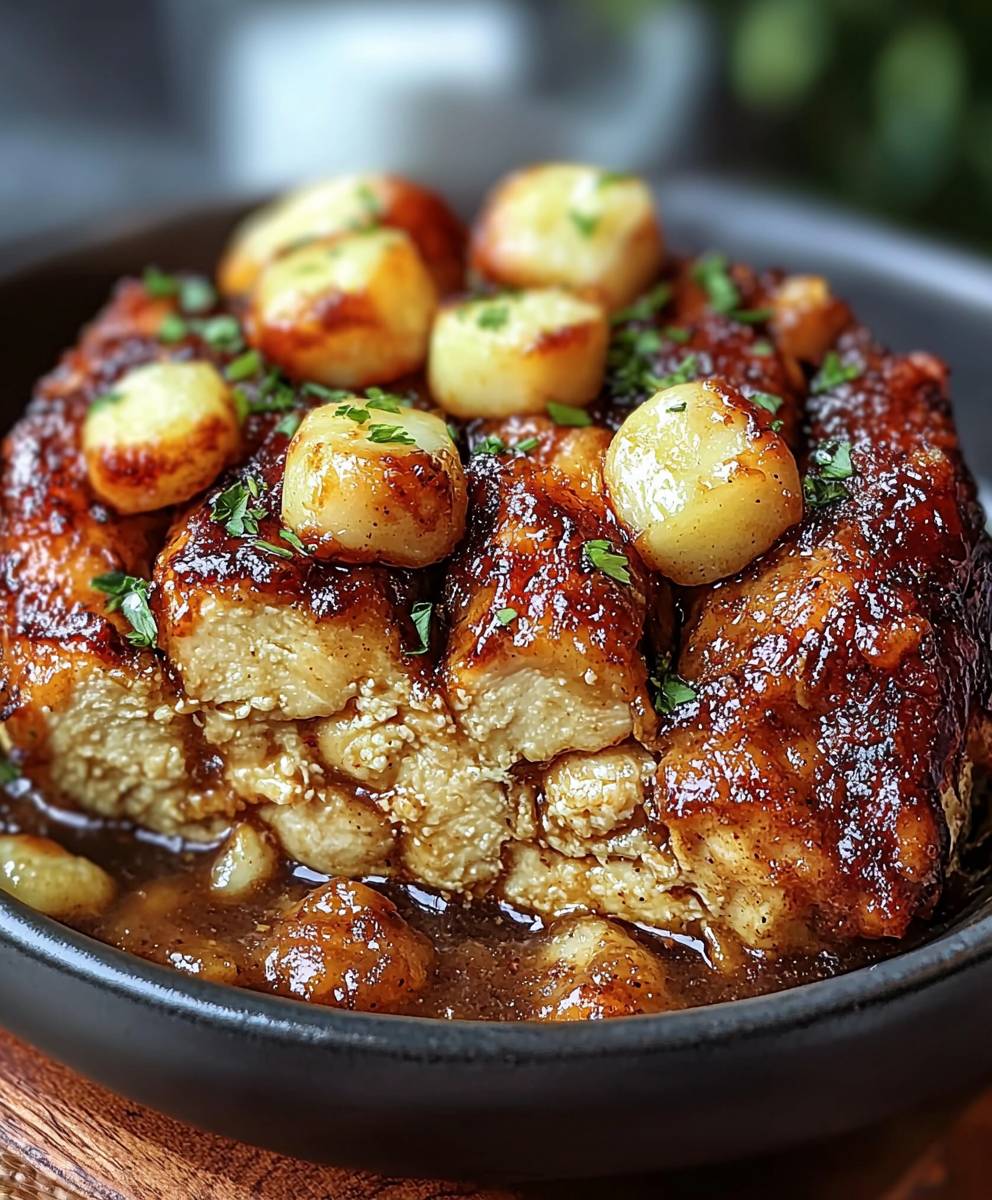Filipino Adobo Chicken: the dish that’s more than just a recipe; it’s a culinary hug from the Philippines! Imagine tender chicken, simmered in a tangy, savory sauce that’s both comforting and exciting to the palate. Have you ever tasted something so simple, yet so profoundly flavorful that it instantly transports you to another place? That’s the magic of Adobo.
Adobo, derived from the Spanish word “adobar” meaning “to marinade,” has a rich history deeply intertwined with Filipino culture. It’s believed that the indigenous Filipinos were already using a similar method of preserving meat with vinegar and salt long before the Spanish arrived. Over time, soy sauce, peppercorns, and bay leaves were incorporated, creating the Adobo we know and love today. It’s considered by many to be the unofficial national dish of the Philippines, with countless variations passed down through generations.
What makes Filipino Adobo Chicken so universally adored? It’s the perfect balance of salty, sour, and savory flavors. The chicken becomes incredibly tender as it braises in the flavorful sauce, and the aroma that fills your kitchen is simply irresistible. Plus, it’s incredibly versatile! Serve it with steamed rice, use it as a filling for tacos, or even enjoy it cold straight from the fridge. It’s a dish that’s easy to make, satisfying to eat, and guaranteed to become a family favorite. Let’s get cooking!
Ingredients:
- 2 lbs Chicken pieces (thighs, drumsticks, and wings work best)
- 1 large Onion, quartered
- 6-8 cloves Garlic, minced
- 1/2 cup Soy Sauce (adjust to taste)
- 1/4 cup White Vinegar (adjust to taste)
- 1 cup Water
- 2 Bay Leaves
- 1 teaspoon Black Peppercorns, whole
- 2 tablespoons Cooking Oil
- 1 tablespoon Brown Sugar (optional, for a touch of sweetness)
- Salt to taste (be mindful of the saltiness of the soy sauce)
- Optional: 1-2 Thai Chili peppers, for heat
Preparing the Chicken and Aromatics:
- First, let’s prep our chicken. You can use any cut you like, but I find that bone-in, skin-on pieces like thighs and drumsticks give the best flavor and stay nice and moist. No need to do anything fancy here, just make sure they’re thawed if frozen.
- Next, peel and quarter your large onion. Don’t worry about making them too small; they’ll break down during the cooking process and add a lovely sweetness to the adobo.
- Now, mince your garlic. I like to use a garlic press for this, but you can also finely chop it with a knife. The more garlic, the better, in my opinion!
- If you’re using chili peppers, now’s the time to add them. I like to add them whole so that the heat infuses slowly. If you want a spicier dish, you can slice them open or chop them. Remember to wash your hands thoroughly after handling chili peppers!
The Braising Process:
- Heat the cooking oil in a large pot or Dutch oven over medium-high heat. Make sure the pot is large enough to hold all the chicken pieces comfortably in a single layer.
- Once the oil is hot, add the chicken pieces, skin-side down if using skin-on chicken. Brown the chicken on all sides. This step is crucial for developing a rich, flavorful base for the adobo. Don’t overcrowd the pot; you may need to do this in batches. If you overcrowd the pot, the chicken will steam instead of brown.
- Remove the browned chicken from the pot and set aside. Don’t worry about cooking it all the way through at this point; it will finish cooking in the sauce.
- In the same pot, add the quartered onions and cook until softened and slightly translucent, about 5-7 minutes. Stir occasionally to prevent them from burning.
- Add the minced garlic and cook for another minute, until fragrant. Be careful not to burn the garlic, as it can become bitter.
- Pour in the soy sauce and vinegar. Let it simmer for a minute or two, allowing the flavors to meld together. The mixture will smell quite pungent at this stage, but don’t worry, it will mellow out as it cooks.
- Add the water, bay leaves, and whole black peppercorns. Stir to combine.
- Return the browned chicken to the pot, arranging it in a single layer. Make sure the chicken is mostly submerged in the liquid. If not, add a little more water.
- Bring the mixture to a boil, then reduce the heat to low, cover the pot, and simmer for at least 45 minutes to 1 hour, or until the chicken is very tender and easily pulls away from the bone. The longer it simmers, the more flavorful it will become.
- After 45 minutes, check the chicken for tenderness. If it’s not quite there yet, continue simmering for another 15-30 minutes.
- Once the chicken is tender, remove the lid and increase the heat to medium. Allow the sauce to reduce and thicken to your desired consistency. This can take anywhere from 10-20 minutes, depending on how much liquid is in the pot. Stir occasionally to prevent the sauce from sticking to the bottom of the pot.
- If you’re using brown sugar, add it now and stir until dissolved. Taste the sauce and adjust the seasoning as needed. You may need to add a little salt, but be mindful of the saltiness of the soy sauce.
- Remove the bay leaves before serving.
Serving Suggestions:
- Serve the chicken adobo hot over steamed rice. The sauce is delicious spooned over the rice.
- Garnish with chopped green onions or parsley, if desired.
- Adobo is even better the next day, as the flavors have had time to meld together even more.
- Leftovers can be stored in the refrigerator for up to 3-4 days.
Variations and Tips:
- Pork Adobo: You can easily substitute pork for chicken in this recipe. Pork belly, shoulder, or ribs work well. The cooking time may need to be adjusted depending on the cut of pork you use.
- Vegetable Adobo: For a vegetarian version, try using firm tofu, mushrooms, or eggplant.
- Adobo with Coconut Milk: For a richer, creamier adobo, add a can of coconut milk during the last 15 minutes of cooking.
- Sweet Adobo: Increase the amount of brown sugar for a sweeter adobo. You can also add a splash of pineapple juice.
- Spicy Adobo: Add more chili peppers or a pinch of chili flakes for a spicier adobo.
- Vinegar Tip: Don’t be afraid of the vinegar! It’s essential for the characteristic adobo flavor. However, you can adjust the amount to your liking. Some people prefer a more vinegary adobo, while others prefer a milder flavor.
- Soy Sauce Tip: Use a good quality soy sauce for the best flavor. I prefer using a naturally brewed soy sauce.
- Browning the Chicken: Don’t skip the step of browning the chicken! This is crucial for developing a rich, flavorful base for the adobo.
- Simmering Time: The longer you simmer the adobo, the more tender the chicken will become and the more flavorful the sauce will be.
- Reducing the Sauce: Allow the sauce to reduce and thicken to your desired consistency. This will concentrate the flavors and create a delicious glaze for the chicken.
- Storing Adobo: Adobo is a great make-ahead dish. It can be stored in the refrigerator for up to 3-4 days and reheated. The flavors actually improve over time.
- Serving Adobo: Adobo is traditionally served with steamed rice. It’s also delicious with noodles or vegetables.
Troubleshooting:
- Chicken is dry: If the chicken is dry, it may have been overcooked. Next time, try reducing the simmering time or adding more liquid to the pot.
- Sauce is too thin: If the sauce is too thin, continue simmering it until it reduces and thickens to your desired consistency. You can also add a cornstarch slurry (1 tablespoon cornstarch mixed with 2 tablespoons cold water) to thicken the sauce.
- Sauce is too salty: If the sauce is too salty, add a little water or a pinch of sugar to balance the flavors.
- Sauce is too sour: If the sauce is too sour, add a little sugar or a splash of soy sauce to balance the flavors.
- Adobo is not flavorful enough: If the adobo is not flavorful enough, try adding more garlic, soy sauce, or vinegar. You can also add a pinch of MSG (optional) to enhance the flavors.
Nutritional Information (approximate, per serving):
- Calories: 400-500
- Protein: 40-50g
- Fat: 20-30g
- Carbohydrates: 10-20g
Note: Nutritional information may vary depending on the specific ingredients and portion sizes used.
Conclusion:
This isn’t just another chicken recipe; it’s an invitation to experience the heart and soul of Filipino cuisine. The rich, savory, and tangy flavors of this Filipino Adobo Chicken are truly unforgettable, a symphony of soy sauce, vinegar, garlic, and peppercorns that dance on your palate. I genuinely believe this recipe is a must-try because it’s more than just a meal; it’s a cultural experience, a taste of home for many, and a delightful discovery for those unfamiliar with Filipino flavors. The beauty of adobo lies in its simplicity and adaptability, making it a perfect dish for both weeknight dinners and special occasions.
But why is this particular recipe so special? It’s all about the balance. I’ve spent years perfecting the ratio of ingredients to achieve that perfect harmony of salty, sour, and savory. The chicken, braised to tender perfection, absorbs all the wonderful flavors, resulting in a dish that’s both comforting and exciting. It’s a dish that will have your family and friends asking for seconds, and maybe even the recipe!
Now, let’s talk about serving suggestions and variations. Traditionally, Filipino Adobo Chicken is served with steamed white rice, which perfectly complements the rich sauce. The rice soaks up all the delicious juices, ensuring that no flavor goes to waste. However, don’t be afraid to get creative! You can also serve it with cauliflower rice for a low-carb option, or even alongside some roasted vegetables like broccoli or green beans.
For variations, consider adding a bay leaf or two during the braising process for an extra layer of aroma. Some people also like to add a touch of sugar or honey to balance the acidity of the vinegar. If you’re feeling adventurous, try adding some potatoes or hard-boiled eggs to the pot during the last 30 minutes of cooking. These additions will soak up the sauce and add a hearty element to the dish. Another popular variation is to add a splash of coconut milk for a creamier, richer adobo. The possibilities are endless!
Don’t be intimidated by the seemingly long list of ingredients. Most of them are pantry staples, and the cooking process is incredibly straightforward. Trust me, even if you’re a beginner cook, you can easily master this recipe. The key is to be patient and let the chicken simmer in the sauce until it’s fall-off-the-bone tender. The longer it simmers, the more flavorful it becomes.
I truly hope you’ll give this Filipino Adobo Chicken recipe a try. It’s a dish that I hold near and dear to my heart, and I’m confident that it will become a favorite in your household as well. Once you’ve made it, I’d love to hear about your experience! Did you make any variations? What did you serve it with? What did your family think? Share your photos and stories in the comments below. I can’t wait to see your creations and hear your feedback. Happy cooking, and enjoy the delicious flavors of the Philippines! This recipe is a guaranteed crowd-pleaser, and I’m excited for you to discover the magic of adobo. So, gather your ingredients, put on some music, and get ready to embark on a culinary adventure! You won’t regret it.
Filipino Adobo Chicken: The Ultimate Guide to This Classic Dish
Tender chicken braised in a savory, tangy, and slightly sweet soy sauce and vinegar-based sauce. A flavorful and easy one-pot meal!
Ingredients
- 2 lbs Chicken pieces (thighs, drumsticks, and wings work best)
- 1 large Onion, quartered
- 6-8 cloves Garlic, minced
- 1/2 cup Soy Sauce (adjust to taste)
- 1/4 cup White Vinegar (adjust to taste)
- 1 cup Water
- 2 Bay Leaves
- 1 teaspoon Black Peppercorns, whole
- 2 tablespoons Cooking Oil
- 1 tablespoon Brown Sugar (optional, for a touch of sweetness)
- Salt to taste (be mindful of the saltiness of the soy sauce)
- Optional: 1-2 Thai Chili peppers, for heat
Instructions
- Prepare Chicken and Aromatics: Prep the chicken pieces. Peel and quarter the onion. Mince the garlic. If using, add chili peppers whole, sliced, or chopped.
- Brown the Chicken: Heat cooking oil in a large pot or Dutch oven over medium-high heat. Brown the chicken on all sides in batches. Remove chicken and set aside.
- Sauté Aromatics: In the same pot, add quartered onions and cook until softened (5-7 minutes). Add minced garlic and cook until fragrant (about 1 minute).
- Simmer the Adobo: Pour in soy sauce and vinegar; simmer for 1-2 minutes. Add water, bay leaves, and black peppercorns. Stir to combine.
- Braise the Chicken: Return the browned chicken to the pot, arranging in a single layer. Ensure chicken is mostly submerged; add more water if needed.
- Cook: Bring to a boil, then reduce heat to low, cover, and simmer for 45 minutes to 1 hour, or until chicken is very tender.
- Reduce the Sauce: Remove the lid and increase heat to medium. Allow the sauce to reduce and thicken to your desired consistency (10-20 minutes), stirring occasionally.
- Final Touches: If using, add brown sugar and stir until dissolved. Taste and adjust seasoning as needed. Remove bay leaves before serving.
- Serve: Serve hot over steamed rice. Garnish with chopped green onions or parsley, if desired.
Notes
- Chicken Choice: Bone-in, skin-on chicken pieces like thighs and drumsticks provide the best flavor and moisture.
- Browning is Key: Don’t skip browning the chicken; it develops a rich, flavorful base.
- Simmering Time: The longer the adobo simmers, the more tender the chicken and flavorful the sauce.
- Vinegar: Adjust the amount of vinegar to your liking.
- Soy Sauce: Use a good quality soy sauce.
- Variations:
- Pork Adobo: Substitute pork for chicken.
- Vegetable Adobo: Use tofu, mushrooms, or eggplant.
- Adobo with Coconut Milk: Add coconut milk during the last 15 minutes of cooking.
- Sweet Adobo: Increase brown sugar or add pineapple juice.
- Spicy Adobo: Add more chili peppers or chili flakes.
- Storage: Leftovers can be stored in the refrigerator for up to 3-4 days. Flavors improve over time.
- Troubleshooting:
- Chicken is dry: Reduce simmering time or add more liquid.
- Sauce is too thin: Continue simmering to reduce or add a cornstarch slurry.
- Sauce is too salty: Add water or sugar.
- Sauce is too sour: Add sugar or soy sauce.
- Adobo is not flavorful enough: Add more garlic, soy sauce, or vinegar.





